
Illustrative Math Alignment: Grade 8 Unit 3
Functions and Volume
Lesson 19: Estimating a Hemisphere
Use the following Media4Math resources with this Illustrative Math lesson.
| Thumbnail Image | Title | Body | Curriculum Topic |
|---|---|---|---|
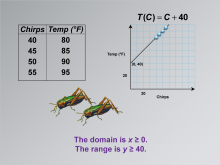
|
Math Clip Art--Applications of Linear Functions: Cricket Chirps 10 | Math Clip Art--Applications of Linear Functions: Cricket Chirps 10TopicLinear Functions DescriptionThis image concludes the series on applications of linear functions, focusing on the domain and range of the cricket chirps-temperature model. It visually represents the statement "The domain is x ≥ 0. The range is y ≥ 40," which provides crucial information about the limitations and applicability of the linear function. |
Graphs of Linear Functions and Slope-Intercept Form |

|
Math Clip Art--Applications of Linear Functions: Distance vs. Time 01 | Math Clip Art--Applications of Linear Functions: Distance vs. Time 01TopicLinear Functions DescriptionThis image serves as the title card for a series of math clip art illustrations demonstrating applications of linear functions, specifically focusing on distance versus time scenarios. The series, comprising ten images, is designed to explore linear models for speed calculations using distance-time data. This introductory image sets the stage for students to delve into the practical applications of linear functions in real-world contexts. |
Graphs of Linear Functions and Slope-Intercept Form |
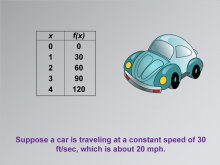
|
Math Clip Art--Applications of Linear Functions: Distance vs. Time 02 | Math Clip Art--Applications of Linear Functions: Distance vs. Time 02TopicLinear Functions DescriptionThis math clip art image is part of a series illustrating applications of linear functions, focusing on building a linear function model for distance versus time. The image presents a car and a data table, introducing a scenario where a car travels at a constant speed of 30 feet per second, which is approximately 20 miles per hour. This visual representation helps students connect abstract mathematical concepts to real-world situations. |
Graphs of Linear Functions and Slope-Intercept Form |
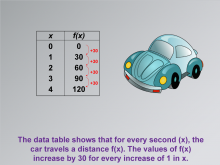
|
Math Clip Art--Applications of Linear Functions: Distance vs. Time 03 | Math Clip Art--Applications of Linear Functions: Distance vs. Time 03TopicLinear Functions DescriptionThis math clip art image continues the series on applications of linear functions, focusing on the relationship between distance and time. It builds upon the previous image, showing an expanded data table that illustrates how the distance traveled (represented by f(x)) increases for each second (x) that passes. The image emphasizes that for every increase of 1 in x, the values of f(x) increase by 30, corresponding to the car's speed of 30 feet per second. |
Graphs of Linear Functions and Slope-Intercept Form |

|
Math Clip Art--Applications of Linear Functions: Distance vs. Time 04 | Math Clip Art--Applications of Linear Functions: Distance vs. Time 04TopicLinear Functions DescriptionThis math clip art image is part of a series demonstrating applications of linear functions, specifically in modeling the relationship between distance and time. The image introduces a graph that visually represents the data from the previous illustrations. It shows a distance-vs-time graph based on the car's movement, clearly depicting a linear function. |
Graphs of Linear Functions and Slope-Intercept Form |

|
Math Clip Art--Applications of Linear Functions: Distance vs. Time 05 | Math Clip Art--Applications of Linear Functions: Distance vs. Time 05TopicLinear Functions DescriptionThis math clip art image continues the series on applications of linear functions, focusing on the distance-time relationship. It builds upon the previous graph by connecting the data points with a continuous line. The image emphasizes that because the car moves continuously, the linear function model is represented by this unbroken line, not just discrete points. |
Graphs of Linear Functions and Slope-Intercept Form |
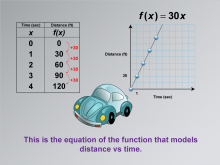
|
Math Clip Art--Applications of Linear Functions: Distance vs. Time 06 | Math Clip Art--Applications of Linear Functions: Distance vs. Time 06TopicLinear Functions DescriptionThis math clip art image is part of a series illustrating applications of linear functions, specifically modeling the relationship between distance and time. The image introduces the equation f(x) = 30x, which represents the function that models the car's movement. This equation encapsulates the linear relationship between time (x) and distance (f(x)) that has been explored in previous images. |
Graphs of Linear Functions and Slope-Intercept Form |
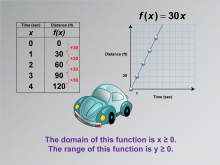
|
Math Clip Art--Applications of Linear Functions: Distance vs. Time 07 | Math Clip Art--Applications of Linear Functions: Distance vs. Time 07TopicLinear Functions DescriptionThis math clip art image continues the series on applications of linear functions, focusing on the domain and range of the distance-time function. The image emphasizes that the domain of this function is x ≥ 0, and the range is y ≥ 0. This representation helps students understand the practical constraints on the variables in real-world applications of linear functions. |
Graphs of Linear Functions and Slope-Intercept Form |
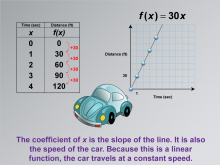
|
Math Clip Art--Applications of Linear Functions: Distance vs. Time 08 | Math Clip Art--Applications of Linear Functions: Distance vs. Time 08TopicLinear Functions DescriptionThis math clip art image continues the series on applications of linear functions, focusing on the relationship between distance and time. It builds upon previous illustrations by emphasizing that the coefficient of x in the equation f(x) = 30x represents both the slope of the line and the speed of the car. This image reinforces the concept that in a linear function, the rate of change remains constant throughout. |
Graphs of Linear Functions and Slope-Intercept Form |
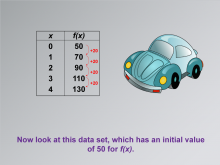
|
Math Clip Art--Applications of Linear Functions: Distance vs. Time 09 | Math Clip Art--Applications of Linear Functions: Distance vs. Time 09TopicLinear Functions DescriptionThis math clip art image is part of a series illustrating applications of linear functions, with a focus on the distance-time relationship. It presents a new scenario with a car and an updated data table. The image likely introduces a different speed or starting point, allowing students to compare and contrast with the previous example and explore how changes in initial conditions affect the linear function. |
Graphs of Linear Functions and Slope-Intercept Form |
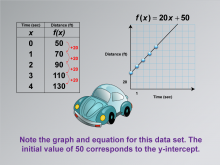
|
Math Clip Art--Applications of Linear Functions: Distance vs. Time 10 | Math Clip Art--Applications of Linear Functions: Distance vs. Time 10TopicLinear Functions DescriptionThis math clip art image concludes the series on applications of linear functions in the context of distance versus time relationships. It presents a linear graph corresponding to the data table introduced in the previous image. This visual representation allows students to see how the new scenario translates into a graphical form, reinforcing the connection between tabular data and its linear graph. |
Graphs of Linear Functions and Slope-Intercept Form |

|
Math Clip Art--Applications of Linear Functions: Hooke's Law 01 | Math Clip Art--Applications of Linear Functions: Hooke's Law 01TopicLinear Functions DescriptionThis image serves as the title card for a series of illustrations demonstrating applications of linear functions, specifically focusing on Hooke's Law. The series, comprising eight images, explores the relationship between force and displacement in springs, showcasing how linear models can represent real-world phenomena. |
Graphs of Linear Functions, Slope-Intercept Form and Proportions |
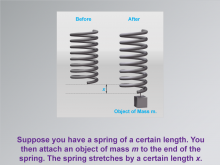
|
Math Clip Art--Applications of Linear Functions: Hooke's Law 02 | Math Clip Art--Applications of Linear Functions: Hooke's Law 02TopicLinear Functions DescriptionThis image is part of a series illustrating applications of linear functions, focusing on Hooke's Law. It depicts a spring before and after being stretched by a weight, visually representing the fundamental concept of Hooke's Law. The illustration shows a spring in its original state and then stretched by an object of mass m, extending by a length x. This visual representation helps students understand the relationship between the applied force (weight) and the resulting displacement of the spring, which forms the basis of the linear function in Hooke's Law. |
Graphs of Linear Functions, Slope-Intercept Form and Proportions |

|
Math Clip Art--Applications of Linear Functions: Hooke's Law 03 | Math Clip Art--Applications of Linear Functions: Hooke's Law 03TopicLinear Functions DescriptionThis image is a continuation of the series on applications of linear functions, specifically illustrating Hooke's Law. It builds upon the previous image by introducing the mathematical equation F(x) = kx, which is the core of Hooke's Law. The illustration shows that when a spring is stretched a distance x, a force F(x) is generated that is proportional to x. This visual representation, combined with the equation, helps students understand the linear relationship between force and displacement in springs. |
Graphs of Linear Functions, Slope-Intercept Form and Proportions |
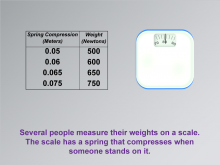
|
Math Clip Art--Applications of Linear Functions: Hooke's Law 04 | Math Clip Art--Applications of Linear Functions: Hooke's Law 04TopicLinear Functions DescriptionThis image is part of a series demonstrating applications of linear functions, focusing on Hooke's Law. It presents a practical application of the law by showing a data table alongside a weight scale, illustrating how Hooke's Law applies to everyday objects. |
Graphs of Linear Functions, Slope-Intercept Form and Proportions |
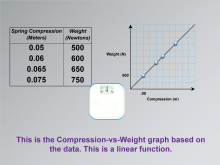
|
Math Clip Art--Applications of Linear Functions: Hooke's Law 05 | Math Clip Art--Applications of Linear Functions: Hooke's Law 05TopicLinear Functions DescriptionThis image is a continuation of the series on applications of linear functions, specifically illustrating Hooke's Law. It builds upon the previous image by presenting a graph of the data collected from the weight scale experiment. The illustration shows a Compression-vs-Weight graph based on the data from the weight scale. The graph displays a clear linear relationship, with data points connected by a straight line. This visual representation helps students see how the abstract concept of a linear function manifests in real-world data. |
Graphs of Linear Functions, Slope-Intercept Form and Proportions |
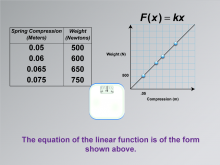
|
Math Clip Art--Applications of Linear Functions: Hooke's Law 06 | Math Clip Art--Applications of Linear Functions: Hooke's Law 06TopicLinear Functions DescriptionThis image is part of a series demonstrating applications of linear functions, specifically focusing on Hooke's Law. It builds upon the previous images by introducing the general form of the linear function equation that describes the relationship observed in the weight scale experiment. |
Graphs of Linear Functions, Slope-Intercept Form and Proportions |

|
Math Clip Art--Applications of Linear Functions: Hooke's Law 07 | Math Clip Art--Applications of Linear Functions: Hooke's Law 07TopicLinear Functions DescriptionThis image is part of a series illustrating applications of linear functions, focusing on Hooke's Law. It builds upon previous images by demonstrating how to calculate the spring constant 'k' using the data collected from the weight scale experiment. Note: Here is the link to the video referenced: https://www.media4math.com/library/42143/asset-preview |
Graphs of Linear Functions, Slope-Intercept Form and Proportions |
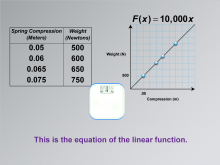
|
Math Clip Art--Applications of Linear Functions: Hooke's Law 08 | Math Clip Art--Applications of Linear Functions: Hooke's Law 08TopicLinear Functions DescriptionThis image represents the culmination of our exploration into applications of linear functions, specifically focusing on Hooke's Law. It serves as the final piece in a series of eight images, tying together all the concepts we've examined throughout this study of spring behavior and weight measurement. |
Graphs of Linear Functions, Slope-Intercept Form and Proportions |

|
Math Clip Art--Applications of Linear Functions: Temperature Conversion 01 | Math Clip Art--Applications of Linear Functions: Temperature Conversion 01TopicLinear Functions DescriptionThis image serves as an introduction to a series of math clip art illustrations demonstrating applications of linear functions, specifically focusing on temperature conversion. The title card presents "Applications of Linear Functions: Temperature Conversion," setting the stage for a comprehensive exploration of how linear models can be used to convert between Celsius and Fahrenheit temperatures. |
Graphs of Linear Functions and Slope-Intercept Form |

|
Math Clip Art--Applications of Linear Functions: Temperature Conversion 02 | Math Clip Art--Applications of Linear Functions: Temperature Conversion 02TopicLinear Functions DescriptionThis image is the second in a series illustrating applications of linear functions, focusing on temperature conversion. It presents a visual representation of thermometers alongside a data table that displays Celsius temperatures (x) and their corresponding Fahrenheit temperatures f(x). This pairing of visual and tabular data helps students connect the abstract concept of linear functions to the concrete idea of temperature scales. |
Graphs of Linear Functions and Slope-Intercept Form |
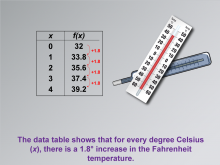
|
Math Clip Art--Applications of Linear Functions: Temperature Conversion 03 | Math Clip Art--Applications of Linear Functions: Temperature Conversion 03TopicLinear Functions DescriptionThis image is the third in a series demonstrating applications of linear functions through temperature conversion. It builds upon the previous image by highlighting a key observation: for every degree Celsius increase, there is a corresponding 1.8° increase in the Fahrenheit temperature. This insight is crucial in understanding the linear relationship between Celsius and Fahrenheit scales. |
Graphs of Linear Functions and Slope-Intercept Form |
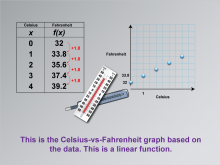
|
Math Clip Art--Applications of Linear Functions: Temperature Conversion 04 | Math Clip Art--Applications of Linear Functions: Temperature Conversion 04TopicLinear Functions DescriptionThis image is part of a series illustrating applications of linear functions, focusing on temperature conversion. It builds upon previous images by introducing a data graph that visually represents the relationship between Celsius and Fahrenheit temperatures. The graph reinforces the key observation that for every degree Celsius increase, there is a corresponding 1.8° increase in the Fahrenheit temperature. |
Graphs of Linear Functions and Slope-Intercept Form |
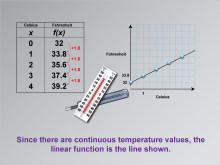
|
Math Clip Art--Applications of Linear Functions: Temperature Conversion 05 | Math Clip Art--Applications of Linear Functions: Temperature Conversion 05TopicLinear Functions DescriptionThis image continues the series on applications of linear functions in temperature conversion. It builds upon the previous graph by connecting the data points with a straight line. This visual representation emphasizes the continuous nature of temperature values and clearly illustrates the linear relationship between Celsius and Fahrenheit scales. |
Graphs of Linear Functions and Slope-Intercept Form |

|
Math Clip Art--Applications of Linear Functions: Temperature Conversion 06 | Math Clip Art--Applications of Linear Functions: Temperature Conversion 06TopicLinear Functions DescriptionThis image is a crucial part of the series on applications of linear functions in temperature conversion. It introduces the mathematical equation f(x) = 1.8x + 32, which represents the temperature conversion function from Celsius to Fahrenheit. This equation is the culmination of the observations and data analysis from the previous images in the series. |
Graphs of Linear Functions and Slope-Intercept Form |
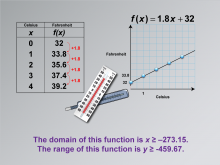
|
Math Clip Art--Applications of Linear Functions: Temperature Conversion 07 | Math Clip Art--Applications of Linear Functions: Temperature Conversion 07TopicLinear Functions DescriptionThis image continues the exploration of linear functions in temperature conversion by introducing the concepts of domain and range. It specifies that the domain of the temperature conversion function is x ≥ -273.15, and the range is y ≥ -459.67. These limits are crucial in understanding the real-world constraints on the mathematical model. |
Graphs of Linear Functions and Slope-Intercept Form |
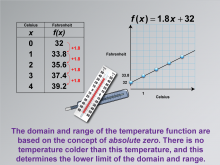
|
Math Clip Art--Applications of Linear Functions: Temperature Conversion 08 | Math Clip Art--Applications of Linear Functions: Temperature Conversion 08TopicLinear Functions DescriptionThis image delves deeper into the concept of domain and range in the context of temperature conversion. It explains that the limits of the temperature function are based on the concept of absolute zero, the lowest theoretically possible temperature. This fundamental principle of physics determines the lower bounds of both the domain and range of the temperature conversion function. |
Graphs of Linear Functions and Slope-Intercept Form |

|
Math Clip Art--Applications of Linear Functions: Temperature Conversion 09 | Math Clip Art--Applications of Linear Functions: Temperature Conversion 09TopicLinear Functions DescriptionThis final image in the series on applications of linear functions in temperature conversion focuses on the significance of the coefficient of x in the linear equation. It emphasizes that this coefficient, 1.8 in the equation f(x) = 1.8x + 32, represents both the slope of the line and the temperature conversion rate. |
Graphs of Linear Functions and Slope-Intercept Form |
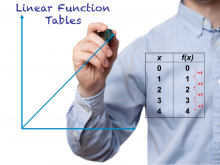
|
Math Clip Art--Linear Function Tables 01 | Math Clip Art--Linear Function Concepts--Linear Function Tables 01TopicLinear Functions DescriptionThis image is part of a series illustrating key concepts in linear functions, specifically focusing on linear function tables. It serves as a title card for a set of 10 clip art images that explore linear functions in tabular and graph form. This visual introduction sets the stage for understanding how linear functions can be represented and analyzed using tables. |
Graphs of Linear Functions and Slope-Intercept Form |
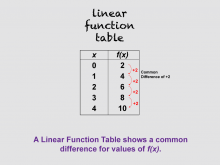
|
Math Clip Art--Linear Function Tables 02 | Math Clip Art--Linear Function Concepts--Linear Function Tables 02TopicLinear Functions DescriptionThis image is part of a series illustrating key concepts in linear functions, focusing on linear function tables. It presents a data table demonstrating that a linear function table shows a common difference for values of f(x). This visual representation helps students understand the fundamental characteristic of linear functions - the constant rate of change. |
Graphs of Linear Functions and Slope-Intercept Form |
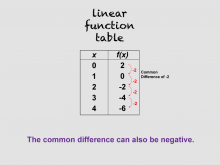
|
Math Clip Art--Linear Function Tables 03 | Math Clip Art--Linear Function Concepts--Linear Function Tables 03TopicLinear Functions DescriptionThis image is part of a series illustrating key concepts in linear functions, specifically linear function tables. It builds on the previous image by showing that the common difference in a linear function can also be negative. This concept is crucial for understanding decreasing linear functions and their representation in tabular form. |
Graphs of Linear Functions and Slope-Intercept Form |
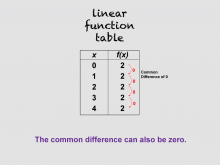
|
Math Clip Art--Linear Function Tables 04 | Math Clip Art--Linear Function Concepts--Linear Function Tables 04TopicLinear Functions DescriptionThis image is part of a series illustrating key concepts in linear functions, focusing on linear function tables. It presents a new version of the previous table, this time demonstrating that the common difference can also be zero. This concept introduces students to constant functions, a special case of linear functions where the output remains the same regardless of the input. |
Graphs of Linear Functions and Slope-Intercept Form |
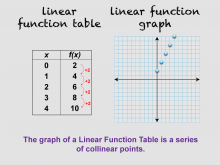
|
Math Clip Art--Linear Function Tables 05 | Math Clip Art--Linear Function Concepts--Linear Function Tables 05TopicLinear Functions DescriptionThis image is part of a series illustrating key concepts in linear functions, focusing on the relationship between linear function tables and graphs. It shows both a data table and a linear graph of data points, demonstrating that the graph of a Linear Function Table is a series of collinear points. This visual representation helps students connect tabular and graphical representations of linear functions. |
Graphs of Linear Functions and Slope-Intercept Form |
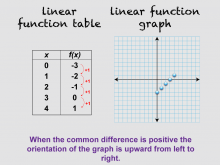
|
Math Clip Art--Linear Function Tables 06 | Math Clip Art--Linear Function Concepts--Linear Function Tables 06TopicLinear Functions DescriptionThis image is part of a series illustrating key concepts in linear functions, focusing on linear function tables and their corresponding graphs. It presents a variation of the previous image with a new set of data, demonstrating that when the common difference is positive, the orientation of the graph is upward from left to right. This helps students understand the concept of positive slope in linear functions. |
Graphs of Linear Functions and Slope-Intercept Form |
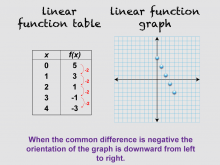
|
Math Clip Art--Linear Function Tables 07 | Math Clip Art--Linear Function Concepts--Linear Function Tables 07TopicLinear Functions DescriptionThis image is part of a series illustrating key concepts in linear functions, focusing on linear function tables and their corresponding graphs. It shows a variation of the previous image with a new set of data, demonstrating that when the common difference is negative, the orientation of the graph is downward from left to right. This helps students understand the concept of negative slope in linear functions. |
Graphs of Linear Functions and Slope-Intercept Form |
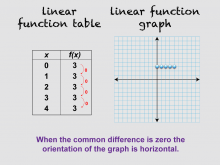
|
Math Clip Art--Linear Function Tables 08 | Math Clip Art--Linear Function Concepts--Linear Function Tables 08TopicLinear Functions DescriptionThis image is part of a series illustrating key concepts in linear functions, focusing on linear function tables and their corresponding graphs. It presents a variation of the previous image with a new set of data, showing that when the common difference is zero, the orientation of the graph is horizontal. This helps students understand the concept of zero slope in linear functions, also known as constant functions. |
Graphs of Linear Functions and Slope-Intercept Form |
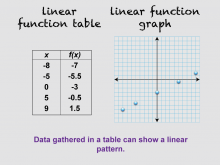
|
Math Clip Art--Linear Function Tables 09 | Math Clip Art--Linear Function Concepts--Linear Function Tables 09TopicLinear Functions DescriptionThis image is part of a series illustrating key concepts in linear functions, focusing on linear function tables. It shows a variation of the previous image with a new set of data, demonstrating that data gathered in a table can show a linear pattern. This concept helps students understand how to identify linear relationships from tabular data. |
Graphs of Linear Functions and Slope-Intercept Form |
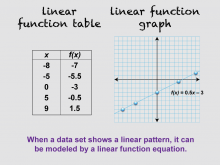
|
Math Clip Art--Linear Function Tables 10 | Math Clip Art--Linear Function Concepts--Linear Function Tables 10TopicLinear Functions DescriptionThis image is part of a series illustrating key concepts in linear functions, focusing on linear function tables and equations. It continues from the previous image, now including the equation f(x) = 0.5x - 3. This demonstrates that when a data set shows a linear pattern, it can be modeled by a linear function equation. This concept helps students understand the connection between tabular data and algebraic representations of linear functions. |
Graphs of Linear Functions and Slope-Intercept Form |

|
Math Clip Art--Linear Functions Concepts--Graphs of Linear Functions 1 | Math Clip Art--Linear Functions Concepts--Graphs of Linear Functions 1TopicLinear Functions DescriptionThis image serves as a title card for a series of 10 clip art images that explore graphs of linear functions. It sets the stage for understanding how linear functions can be represented and analyzed graphically, introducing students to the visual aspect of these mathematical concepts. Using visual aids like this title card can help engage students and prepare them for the upcoming content. It provides a clear introduction to the topic and helps organize the learning material in a visually appealing way. |
Graphs of Linear Functions and Slope-Intercept Form |
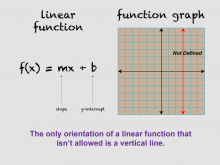
|
Math Clip Art--Linear Functions Concepts--Graphs of Linear Functions 10 | Math Clip Art--Linear Functions Concepts--Graphs of Linear Functions 10TopicLinear Functions DescriptionThis image is the final in a series illustrating key concepts in linear functions, focusing on the special case of vertical lines. It presents a variation of the previous image, now including a vertical line in the graph to demonstrate an important exception in linear functions. The image highlights that vertical lines are the only orientation not allowed in standard linear functions. This concept is crucial for students to understand the limitations of the slope-intercept form and to recognize when they need to use alternative representations. |
Graphs of Linear Functions and Slope-Intercept Form |
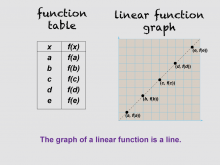
|
Math Clip Art--Linear Functions Concepts--Graphs of Linear Functions 2 | Math Clip Art--Linear Functions Concepts--Graphs of Linear Functions 2TopicLinear Functions DescriptionThis image presents a data table alongside a linear graph with the slope and y-intercept labeled. It demonstrates the connection between tabular data and graphical representation of linear functions, helping students understand how numerical values translate into visual patterns. By incorporating this visual aid, teachers can enhance students' comprehension of the relationship between data points and their graphical representation. This image serves as a bridge between algebraic and geometric interpretations of linear functions. |
Graphs of Linear Functions and Slope-Intercept Form |
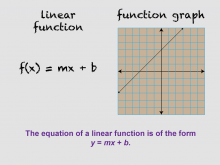
|
Math Clip Art--Linear Functions Concepts--Graphs of Linear Functions 3 | Math Clip Art--Linear Functions Concepts--Graphs of Linear Functions 3TopicLinear Functions DescriptionThis image displays the general form of the slope-intercept equation (y = mx + b) with definitions of m and b. It provides a crucial link between the algebraic representation of linear functions and their graphical interpretation, helping students understand how each component of the equation affects the graph. Using this visual aid can significantly enhance students' understanding of the slope-intercept form and its relationship to linear graphs. It serves as a reference point for discussing how changes in m and b impact the line's appearance on a coordinate plane. |
Graphs of Linear Functions and Slope-Intercept Form |
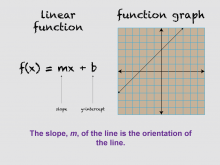
|
Math Clip Art--Linear Functions Concepts--Graphs of Linear Functions 4 | Math Clip Art--Linear Functions Concepts--Graphs of Linear Functions 4TopicLinear Functions DescriptionThis image continues from the previous one, now with labeled slope and y-intercept. It provides a visual breakdown of the general equation for a linear function, helping students understand this fundamental concept in a step-by-step manner. By using this visual aid, teachers can guide students through the process of understanding the slope-intercept form, reinforcing the connection between the algebraic definition and its graphical representation. This image is particularly useful for students who benefit from seeing mathematical concepts broken down into clear, visual steps. |
Graphs of Linear Functions and Slope-Intercept Form |
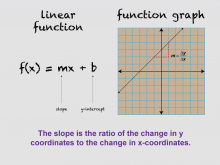
|
Math Clip Art--Linear Functions Concepts--Graphs of Linear Functions 5 | Math Clip Art--Linear Functions Concepts--Graphs of Linear Functions 5TopicLinear Functions DescriptionThis image continues from the previous one, showing the slope calculation ratio. It demonstrates the importance of expressing slope as a ratio, which can help students more easily interpret and compare different linear functions. Incorporating this visual aid into lessons can help reinforce the concept of slope simplification and its importance in analyzing linear functions. It provides a clear example of how mathematical operations can be applied to make expressions more manageable and meaningful. |
Graphs of Linear Functions and Slope-Intercept Form |
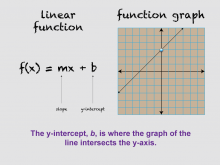
|
Math Clip Art--Linear Functions Concepts--Graphs of Linear Functions 6 | Math Clip Art--Linear Functions Concepts--Graphs of Linear Functions 6TopicLinear Functions DescriptionThis image presents a variation of the previous image with the y-intercept highlighted. It emphasizes the significance of the y-intercept in linear functions, helping students understand its role in determining where the line crosses the y-axis. By using this visual aid, teachers can draw attention to the y-intercept and its importance in interpreting linear functions. This image can help students connect the 'b' value in the slope-intercept form to its graphical representation, enhancing their understanding of how equations relate to graphs. |
Graphs of Linear Functions and Slope-Intercept Form |
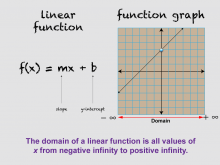
|
Math Clip Art--Linear Functions Concepts--Graphs of Linear Functions 7 | Math Clip Art--Linear Functions Concepts--Graphs of Linear Functions 7TopicLinear Functions DescriptionThis image is part of a series illustrating key concepts in linear functions, focusing on the domain of linear functions. It continues from the previous images in the series, now highlighting the concept of domain in linear functions. The image presents a continuation of the previous graph with the domain identified. This visual representation helps students understand that the domain of a linear function extends infinitely in both directions on the x-axis. |
Graphs of Linear Functions and Slope-Intercept Form |
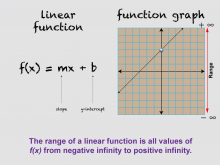
|
Math Clip Art--Linear Functions Concepts--Graphs of Linear Functions 8 | Math Clip Art--Linear Functions Concepts--Graphs of Linear Functions 8TopicLinear Functions DescriptionThis image is part of a series illustrating key concepts in linear functions, focusing on the range of linear functions. It presents a variation of the previous image, now highlighting the concept of range in linear functions. The image shows a variation of the previous graph with a label for the range. This visual aid helps students understand that the range of a linear function, like its domain, extends infinitely in both directions, but on the y-axis. |
Graphs of Linear Functions and Slope-Intercept Form |
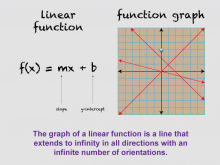
|
Math Clip Art--Linear Functions Concepts--Graphs of Linear Functions 9 | Math Clip Art--Linear Functions Concepts--Graphs of Linear Functions 9TopicLinear Functions DescriptionThis image is part of a series illustrating key concepts in linear functions, focusing on the various orientations of linear functions. It shows the slope-intercept equation alongside several linear graphs, emphasizing the infinite possibilities for linear function orientations. The image demonstrates that linear functions can have an infinite number of orientations, extending infinitely in all directions. This concept helps students understand the versatility and wide-ranging applications of linear functions in modeling real-world relationships. |
Graphs of Linear Functions and Slope-Intercept Form |

|
Math Clip Art--Linear Functions Concepts--Linear Function Representations 1 | Math Clip Art--Linear Functions Concepts--Linear Function Representations 1TopicLinear Functions DescriptionThis image serves as a title card for a series of 14 clip art images that explore ways of presenting linear functions (equations, graphs, and tables). It sets the stage for understanding various representations of linear functions, providing a visual introduction to this important mathematical concept. Using visual aids like this title card can help engage students and prepare them for the upcoming content. It provides a clear introduction to the topic and helps organize the learning material in a visually appealing way. |
Graphs of Linear Functions and Slope-Intercept Form |

|
Math Clip Art--Linear Functions Concepts--Linear Function Representations 10 | Math Clip Art--Linear Functions Concepts--Linear Function Representations 10TopicLinear Functions DescriptionThis image presents a more general form of a Linear Function Machine, represented by ax + b. It introduces students to the standard form of a linear function, helping them understand how different parameters affect the function's behavior. By incorporating this visual aid, teachers can help students see the connection between the function machine concept and the slope-intercept form of a linear equation. This image is particularly useful for discussing how 'a' and 'b' affect the graph of the function. |
Graphs of Linear Functions and Slope-Intercept Form |